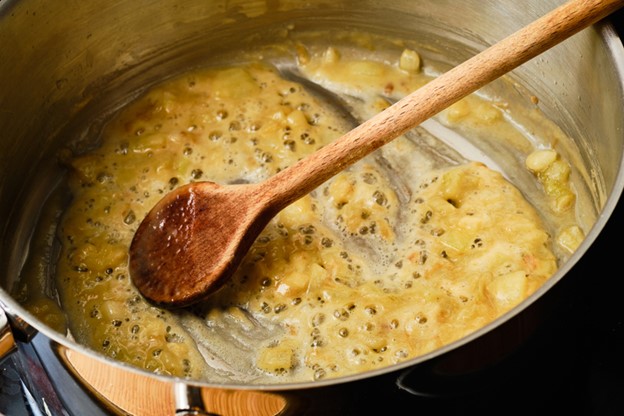Two Simple Cooking Approaches That Are in More Dishes Than You Know!
A cooking blog I turn to from time to time is www.thecookinghobbyist.wordpress.com. Just the other day I was browsing his entry on the difference between mirepoix and roux and found it very interesting. Maybe you will as well. Here’s what I learned:
When it comes to making stews, soups, sauces, pot pies and other dishes, the mirepoix and roux are two things that are invaluable as their base and thickening agent, respectively.

While it has a number of variations in different cultures, a mirepoix is essentially a flavor-adding base consisting of onion, carrot and celery. Whenever you make any kind of soup (with few limitations) you want to always start with a mirepoix. It originated in French cuisine at least 3 centuries ago; if we’ve been using it that long, there has to be a reason right?
Typically, a mirepoix is made by dicing onions, carrots and celery as large or as fine as you require for your dish, then toss them into a fry pan (or a pot) with some melted butter or oil (olive or vegetable, based on preference). That’s it. Simple, yes?

Like anything else, it can be tweaked, so you might add garlic, bacon too (especially if making a carbonara sauce or a cream of potato, leek and bacon soup) which lends its fat to increase the flavor. Red wine is a good addition if making a red or dark sauce/soup/stew or white wine if making a white or light sauce/soup/stew. And you never go wrong with fresh herbs and spices (oregano or basil, for instance).
Now for the roux. It’s also very simple. Flour and fat (butter excels at this). That’s it, that’s all. Melt some butter in a pan (or pot) and slowly add flour while stirring. A good roux is like a paste—very useful for cream-based soups or sauces. It’s essential for things like béchamel sauce or gravy.

Fat is needed to remove the flour’s dry, powdery taste. Also, by cooking the flour with fat, you get some color and taste changes. For example, leave it on heat long enough and you’ll get darker color and deeper taste. Since roux is used mostly for its thickening properties, it needs cooking only until it’s well mixed and has a uniformly golden color (from the butter). However, when making a brown gravy, then you’ll want to cook it a little longer to get that rich brown color and bold flavor gravy-lovers want.
So there you have it. Two simple cooking approaches that are in more dishes than you may realize.
When it comes to making stews, soups, sauces, pot pies and other dishes, the mirepoix and roux are two things that are invaluable as their base and thickening agent, respectively.

While it has a number of variations in different cultures, a mirepoix is essentially a flavor-adding base consisting of onion, carrot and celery. Whenever you make any kind of soup (with few limitations) you want to always start with a mirepoix. It originated in French cuisine at least 3 centuries ago; if we’ve been using it that long, there has to be a reason right?
Typically, a mirepoix is made by dicing onions, carrots and celery as large or as fine as you require for your dish, then toss them into a fry pan (or a pot) with some melted butter or oil (olive or vegetable, based on preference). That’s it. Simple, yes?

Like anything else, it can be tweaked, so you might add garlic, bacon too (especially if making a carbonara sauce or a cream of potato, leek and bacon soup) which lends its fat to increase the flavor. Red wine is a good addition if making a red or dark sauce/soup/stew or white wine if making a white or light sauce/soup/stew. And you never go wrong with fresh herbs and spices (oregano or basil, for instance).
Now for the roux. It’s also very simple. Flour and fat (butter excels at this). That’s it, that’s all. Melt some butter in a pan (or pot) and slowly add flour while stirring. A good roux is like a paste—very useful for cream-based soups or sauces. It’s essential for things like béchamel sauce or gravy.

Fat is needed to remove the flour’s dry, powdery taste. Also, by cooking the flour with fat, you get some color and taste changes. For example, leave it on heat long enough and you’ll get darker color and deeper taste. Since roux is used mostly for its thickening properties, it needs cooking only until it’s well mixed and has a uniformly golden color (from the butter). However, when making a brown gravy, then you’ll want to cook it a little longer to get that rich brown color and bold flavor gravy-lovers want.
So there you have it. Two simple cooking approaches that are in more dishes than you may realize.
 Alice Osborne
Alice Osborne
Weekly Newsletter Contributor since 2006
Email the author! alice@dvo.com
